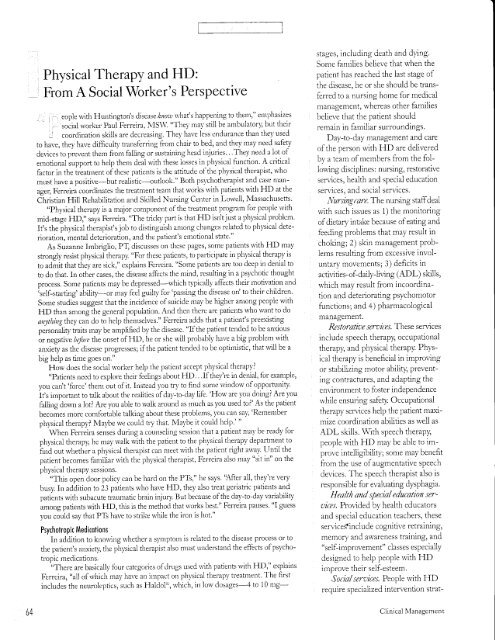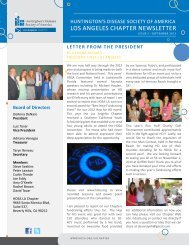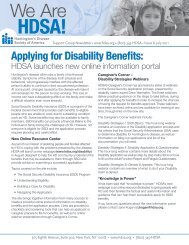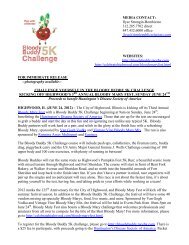T - Huntington's Disease Society of America
T - Huntington's Disease Society of America
T - Huntington's Disease Society of America
You also want an ePaper? Increase the reach of your titles
YUMPU automatically turns print PDFs into web optimized ePapers that Google loves.
Physical Therapy and HD:<br />
- ' From A Social Worker's Perspective<br />
-' I ;,:- eople with Hunting;ton's disease,4ro;e' u'hat's happeling to dretrl,"<br />
- emphasizes<br />
I -- 'social lvorker Paui F-erreira, NIS\V. "They mav still be anrbulator,r'i br-rtheir<br />
,- coordination skills are decrcasing. l-hey have less endurance tl-ran theY trsed<br />
to have, thel'hn1,e difficulq' transferrir.rg fiorn chair to bcd, and the,v rnay need safety<br />
devices to pieventhem fronr falling or sustairrilg head injuries...Thel' 11gecl a lot r:f<br />
ernotional supporto help thenr deal u'ith thcse losses in ph1'sical function. A cr-itical<br />
fbctor in the tr-eatur.rent <strong>of</strong> these patients is the attitude <strong>of</strong> the phvsicai therapist, lvho<br />
rnust have a positive-but realistic--outlook." Both ps)'chodreraPist and case matiageq<br />
Ferreira coordinates the tleatment team tlrat lr,orks rvith patients rvidr HD at tbe<br />
C|u-istian Hill Rcfiabilitatior.r and Skilled Nursing Center ir.r Lorvcll, N4assachr.rsetts.<br />
"Ph,vsical<br />
tlrerapy is a major compone nt <strong>of</strong> the trcatmcnt progfarn for pcople rvith<br />
"TIre<br />
rnid-stage FID," says Fcrreira. trich.part is that HD isrlt just a ph1'sical problem.<br />
It's the ph1,sica1 therapist'sjob to clistinguish anrons changcs relatcd to ph1'sical deterioration,<br />
mental detcrioration, and tllc patient's elt-totional state'"<br />
As Suzanne Imbriglio, P! discusscs o1 drese pagcs, sornc patients t'ith HD 1.ray<br />
"For<br />
strongly resist physical therapl.: these patients, to participate in phl'sical therapv is<br />
to aclilit that the1, are sick," cxirlains Fcrreira. "Some paticuts are t(xr deep in dcnial to<br />
to do that. In otlter cases, the disease affccts the mind, rcsultin$ in a psych6{c thought<br />
process. Son-re patients rnay be depresscd-r'vhicli tvpicall1'affects dreir urotivatiou aud<br />
iself-startilg' 'pzrssinQ<br />
abiliq'-or may leel guilq' for thc diseasc on' to drcir cfiildre1'<br />
Sone studie suggest that the incidence c-,f suicidc tr.rav be l.righer among peoplc rvith<br />
HD than among the general population. Ald then thcrc arc patients rvho u'ant to do<br />
anlthingthcy can do to help themselves." Ferrcim adds th:rt a paticnt's preexisting<br />
"If<br />
persolaliq' 16its tnay be agrplifred by thc disease. tfie patient telded to be anrit'rus<br />
tr negative befc,rc theonset <strong>of</strong> F{l), he or she will probably have a big problenr t'ith<br />
an-xiety as the disease progfesses; if the patient tended to be optimistic, that will be a<br />
big help as tiure goes ott."<br />
Florv does the social rvot-lier help the patient accept physical therapvl<br />
"Patients<br />
leecl to ex;'rlc.rre their- feelings about IfD,. .Iltdrei/re ir.r deniai, for eriamprle,<br />
1'ou cirtr't'force'them out <strong>of</strong> it. L-rstcad i'ou tDr to find some t'indolv <strong>of</strong> oppol'tunirv'<br />
it's important to talk about the real-ities <strong>of</strong> da1'-16-6|n" 6le' 'FIou'' are l'ou doiugi Are you<br />
talling dorvn a lot? A.r-e ),ou able to r.valk around as rnuch as you used tol'As the patient<br />
'RetnemLler<br />
becomes rnore comfortable talking about these problerns, )rotl can sa1"<br />
phvsical therapi'f lVlaybs rve could tr.v drat. N'[at'be it could help'' "<br />
When Ferreir-a sepses during a counseling sessiotr that a patient nral'be readl' f61'<br />
pitysical therapii he lr-ra1'rvalk u,ith tl.re patient to the ph,vsical drerapy deparlrnento<br />
h1d out rvhetfier a ph,vsical therapist can mect rvitlt the patient right au'a1i L]ntil the<br />
patient becorr.res familiar rvitlt the ph1'sical tlierapist. F-erreiralso may "sit in" otr the<br />
phi'sical thcrapy scssions.<br />
"This "After open door policl'can be hard on the PG," he sa1's' all, tl"rey're very<br />
busti In addition to 2J patiertts'w4lo ltave I-ID, diey also treat geriatric patients and<br />
patients with subacute tratunatic brain iljury But because <strong>of</strong> the day-to-da-V variability<br />
among patients rn'ith HD, dris is the method that lr,orks best." Ferreira pauses.<br />
"I guess<br />
you could say that PG havc to str-il;e ivlile the iron is hot."<br />
Psycholropic Medicotions<br />
In addition to lcrorving rvhether a syrxptom is related to thc tlisease Process or to<br />
the patient's aruiiegi the physical therapist also ntust r.urclerstand the eflects <strong>of</strong>pst'chotropic<br />
r.nedications.<br />
"There are basical\, fbur categories <strong>of</strong> drr-rgs r,rsed u'ith patients n'ith FID," explains<br />
Ferreila,<br />
"a1l <strong>of</strong> rvhich tnal' l1n1's an irnpact on ;'l.rrsical therapl'treatnrent' f'he first<br />
includes the ner-rroleptics, suclr as Flalclol", ri'liich, in lou'dclsages-'l to 10 mgstages,<br />
inciuding death and dying.<br />
Some fanrilies believe tl-rat when the<br />
paticnt has reached the last stage <strong>of</strong><br />
the disease, he or she should be transferred<br />
to a nursing horne for medical<br />
mallagement, whereas other families<br />
believe that the patient should<br />
remain in familrar surroundings.<br />
T-\^, r^ l^, -.^'..-.nrent<br />
udy-lw-ud) 1rrarraSLt and care<br />
<strong>of</strong> the person rvith HD are delivered<br />
bJ, u tet- <strong>of</strong> nembers from the follouing<br />
disciplinet: nursing, restorative<br />
sen'ices, health and special education<br />
sen ices, and :ocial services.<br />
h'ursittg carc.'Ihe nursing staffdeal<br />
witl-r such issues as l) the monitoring<br />
<strong>of</strong>dietary intake because <strong>of</strong>eating and<br />
f'eecling problems that ma1 rcsult in<br />
chokingl 2) skin management problems<br />
resulting from excessive invoLuntarv<br />
moverrents; 3) deficits in<br />
activities-<strong>of</strong>-dailpfvltt* (ADL) skiJls,<br />
rvhich may result from incoordination<br />
and deteriorating psychomotor<br />
functions; and 4) pharmacologicai<br />
management.<br />
Rrstotuti:ce serttins. These services<br />
include speech therapy, occupational<br />
therap1,, and physical therapir Physical<br />
drerapy is beneficial in improving<br />
or stabilizing motor abiliti! preveuting<br />
contracrures, and adapting the<br />
enr.ironmento foster independence<br />
rvl'rile ensuring safety. Occupational<br />
thcrapy sen'ices help tJre patient maximize<br />
coordination abilittes as rvell as<br />
ADL skills. \\-itlr speech therapy,<br />
people witli HD may be able to improve<br />
intelJigibility; sonre may benefit<br />
frorn the use <strong>of</strong> augmentative speech<br />
der,'ices. The speech therapist also is<br />
responsible for evaluating dysphagia.<br />
Healtlt and special education seraice-s.<br />
Provided by health educators<br />
and special education tcaclrers, these<br />
servicef include cognitir.e retraining,<br />
rnemor)/ and awareness training, and<br />
"self-ir-nprovement" classes especiaily<br />
designed to help people rvith HD<br />
improve their self-esteem.<br />
Soria/ srrt'ires. Peoplc u itli HD<br />
require specialized intenrention strat-<br />
64 Clinical N4anagement
















